Tortuguero
by
Philip Greenspun
Home : Travel : Costa Rica : One Part
Thursday, January 19, 1995
Edgar, a voluble guide, and his driver picked us
up at the Milvia at 5:40 a.m. We went to a couple of downtown hotels to pick
up Marlene, a Michigan woman, and Chris and Jill, from Orange County. En route
to a small airport used for charter flights, Edgar briefed us on what to
expect.
"On the left side of the plane, you will check the volcanoes. You will also
check a river that has turned yellow because of the minerals from the volcano.
After you are over the mountains surrounding San Jose, you will check banana
plantations on the other side down to the ocean. That is the main use of the
land until you get to Tortuguero."
We really ought to have explained to him the difference between "check" and
"see," but we didn't.
 We piled into a surprisingly large twin Piper with the pilot, a casually
dressed taciturn man with a fancy aviator's watch but no earplugs or headset.
I was relieved when he gave the engines a full run-up and also when I saw the
modern Trimble GPS unit in the dashboard, although with a blue sky and the
strong light of dawn, it would clearly be unnecessary. San Jose is at 3,773
feet [1,150 m] and we climbed to 7400 feet to get through a pass in the
mountains. The city looked beautiful. The volcanoes that had sounded so
impressive in Edgar's description just looked like mountains covered with lush
green foliage.
We piled into a surprisingly large twin Piper with the pilot, a casually
dressed taciturn man with a fancy aviator's watch but no earplugs or headset.
I was relieved when he gave the engines a full run-up and also when I saw the
modern Trimble GPS unit in the dashboard, although with a blue sky and the
strong light of dawn, it would clearly be unnecessary. San Jose is at 3,773
feet [1,150 m] and we climbed to 7400 feet to get through a pass in the
mountains. The city looked beautiful. The volcanoes that had sounded so
impressive in Edgar's description just looked like mountains covered with lush
green foliage.
The only real excitement of the flight came when I turned around to talk to
Chantal and stepped hard on the left rudder pedal; the plane yawed sharply
and the pilot threw me an angry look.
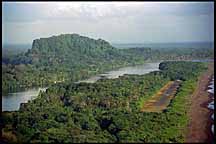 It was only about 7:15 when a palm-lined airstrip appeared on a spit between
the ocean and a long canal. We touched down and a minute later were boating
across the canal toward the Tortuga Lodge, gleaming in the early morning sun.
It was only about 7:15 when a palm-lined airstrip appeared on a spit between
the ocean and a long canal. We touched down and a minute later were boating
across the canal toward the Tortuga Lodge, gleaming in the early morning sun.
We were immediately enveloped in an atmosphere of community. Breakfast was
being served family-style at a long table. We dumped our bags outside the
dining hall. Costa Rica is getting a lot of bad press for theft, but I had no
qualms about leaving my Macintosh and camera bag outside for four hours;
Tortuga Lodge doesn't even have locks on the room doors.
After stuffing our faces with eggs, pancakes, fruit, granola, and the
ubiquitous gallo pinto, we boarded a skiff for a tour through the
canals.
This is the way to see the rainforest. No mosquitoes, no effort, no sweat, no
rocks hitting your legs, a nice breeze off the water, an ice chest full of
complimentary sodas from the lodge, a guide with RADAR for animals. It wasn't
until I did a little hiking in the rainforest that I appreciated how good we
had it in Tortuguero.
 The jungle scenery compared favorably to that which had already awed us down
the Pacuare. In three hours, we saw howler and spider monkeys, toucans, blue
herons, white herons, a great blue heron, tree iguanas, two caimans, and a
sloth. Trees come in two varieties. One kind is comfortable with parasitic
plants and is therefore covered in vines. These have a thick lush appearance.
The other kind has bark that is anathema to vines and these appear very tall
because the trunk is thin and side branches few until an explosion two hundred
feet up in the canopy.
The jungle scenery compared favorably to that which had already awed us down
the Pacuare. In three hours, we saw howler and spider monkeys, toucans, blue
herons, white herons, a great blue heron, tree iguanas, two caimans, and a
sloth. Trees come in two varieties. One kind is comfortable with parasitic
plants and is therefore covered in vines. These have a thick lush appearance.
The other kind has bark that is anathema to vines and these appear very tall
because the trunk is thin and side branches few until an explosion two hundred
feet up in the canopy.
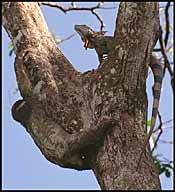 Sloth going down, Iguana going up.
Sloth going down, Iguana going up.
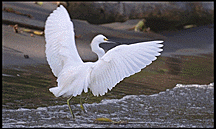
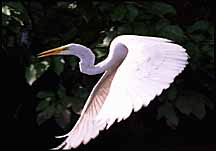
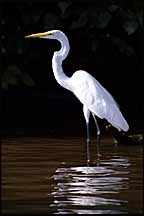
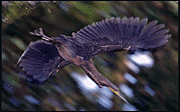
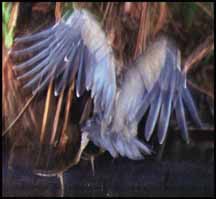
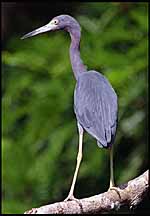
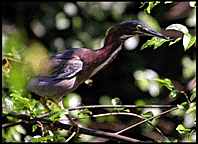



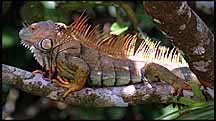
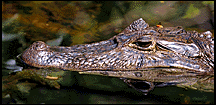
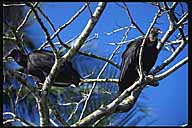
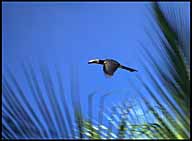
 Lunch was a delicious six-course communal affair. Tortuga Lodge serves the
best food that we found in Costa Rica, which was remarkable considering that
everything has to come in by truck and then up the canal for three hours. In
two days we feasted on octopus, salads with perfect tomatoes, ripe fruit,
strange vegetables, steaks, Mahi-Mahi, and chicken.
Lunch was a delicious six-course communal affair. Tortuga Lodge serves the
best food that we found in Costa Rica, which was remarkable considering that
everything has to come in by truck and then up the canal for three hours. In
two days we feasted on octopus, salads with perfect tomatoes, ripe fruit,
strange vegetables, steaks, Mahi-Mahi, and chicken.
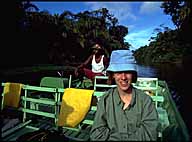
 We went back out from 2:30 until about 6, but didn't see as many animals. The
highlight of the trip was a stop at the little village of Tortuguero. About
1000 people live in the general area and a few hundred are clustered in the
village proper. Children ride their bikes among pigs and chickens, a couple of
shops cater to tourists, one public phone serves most of the community,
chickens roost in trees, every spare open space has been converted to a soccer
field. In a fifteen minute walk, I found a guy tying up bananas in his front
yard, a soccer game in progress on the one regulation field, a young girl
teaching her younger brother to ride a bike, and teenagers gabbing with their
pet parrot.
We went back out from 2:30 until about 6, but didn't see as many animals. The
highlight of the trip was a stop at the little village of Tortuguero. About
1000 people live in the general area and a few hundred are clustered in the
village proper. Children ride their bikes among pigs and chickens, a couple of
shops cater to tourists, one public phone serves most of the community,
chickens roost in trees, every spare open space has been converted to a soccer
field. In a fifteen minute walk, I found a guy tying up bananas in his front
yard, a soccer game in progress on the one regulation field, a young girl
teaching her younger brother to ride a bike, and teenagers gabbing with their
pet parrot.
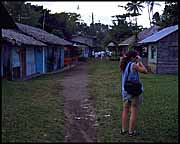
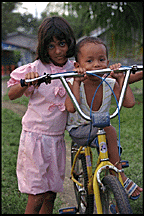
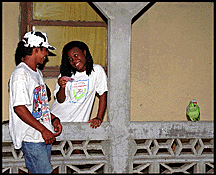
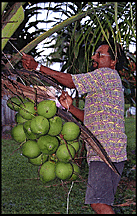
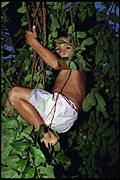

All of Los Angeles seemed to be at dinner: Dave and Ellen, New York Jews
transplanted to Orange County, and Stuart and Leslie, who live in the San
Fernando Valley, arrived to join Chris and Jill. Chris is an anesthesiologist
and both Ellen and Jill were nurses. Ellen works in a plastic surgery clinic
so we talked about the booming plastic surgery industry in Costa Rica.
"It is so much cheaper to have dental work or plastic surgery done here," a
Tico explained, "that you can come here for a long vacation, have the procedure
done, and fly back to the states having spent less than you'd spend for the
procedure alone in the U.S. The only problem is that you have to be sure you
know who you're dealing with."
Ellen said it was the same in L.A.
"Every doctor calls himself a plastic surgeon, but people don't realize that he
might be completely unqualified and inexperienced."
I figured it would be a good time to make friends.
"L.A. is a cultural and spiritual wasteland so people find solace in
materialism and plastic surgery."
Chris chuckled and Jill looked horrified--people didn't talk like that back in
Indiana where she was from.
"Consider this," I continued. "You never hear of people in the Midwest moving
just because they got a little more money. In California, people move every
couple of years even if they don't get more money. It doesn't matter how much
money you have in California as long as you have the stuff; nobody will ask
whether you borrowed or stole it all."
"One of the bad things is fences," noted Leslie, "because they isolate people
from one another. In other parts of the country, if you are having a barbecue
in your backyard, you can lean over and talk to your neighbors. With a fence,
it isn't possible. I'd be ready to move in a second."
"The real problem is working women," I said. "My mom was the person who knew
everyone in the neighborhood and introduced my dad to them. When both partners
work, nobody has time to build a social circle around the house."
"I came to LA ten years ago from Indiana," Jill related, "and hated it for
years. As soon as I got out there, I was sitting by the pool in my apartment
complex and a girl leaned over and said `You're not from California, are you?
You're much too open and friendly. You have to be suspicious of people out
here.' I've found friends with common interests now and have gotten used to
the weather being great all the time. It took years, though."
Dave talked about his career in the computer industry.
"After a few years I wasn't doing programming anymore because there was only so
far you could go. I started my own company and ended up doing management. I
got out about five years ago, though. Now I'm doing retail. It's completely
different but it's fun. I have two franchise party goods superstores."
What about chucking it all and moving to Costa Rica?
"That man is not alive," Ellen pointed to Steve, the manager. "Something
happens to people here. I tried talking to him for awhile today and he's
walking dead, believe me."
Friday, January 20, 1995
"You'll sleep well here," Steve had said. "There's no noise and no
light. Everybody sleeps well in Tortuga."
He was right for we slept dreamlessly under our ceiling fan and straggled into
the dining room at 7:30 for the tail-end of another sumptuous breakfast. If
we'd had any brains, we would have arranged a boat tour with a real naturalist.
The usual boat guides are reasonable at spotting wildlife but they have a
difficult time saying anything very interesting about the animals in English.
We wanted to hike up "the mountain" and arranged a boat and guide with Steve.
People who'd done the hike the day before had talked about coming really close
to a group of white-faced monkeys.
"It rained all night last night," Steve warned, "and the trail is going to be
very difficult."
"It's only 360 feet high," I responded. "How hard could it be?"
Steve just smiled.
Ramon, a weathered fellow with a gold tooth, appeared five minutes later to run
us a half a mile up the canal in a skiff. We got out and started walking
through the flat area near the beach.
"Parrots," Ramon said. His English ultimately proved remarkably good, but he
tended to be a man of few words.
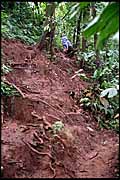
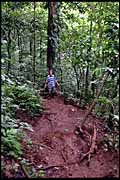 We searched and searched while he pointed. After two minutes of peering, we
finally were able to see the two big green parrots sitting side-by-side talking
to each other. They were so far away and so close to the color of the foliage
that they were tough to pick out even pointing a 350mm lens straight at them.
We searched and searched while he pointed. After two minutes of peering, we
finally were able to see the two big green parrots sitting side-by-side talking
to each other. They were so far away and so close to the color of the foliage
that they were tough to pick out even pointing a 350mm lens straight at them.
Aside from red tree frogs, those were the last animals we saw on what I came
to call the Rainforest Death March. The trail was treacherous, muddy, steep,
and hard. Sweat poured down my face in rivers, mixed with DEET and began to
dissolve my plastic cameras. Mosquitoes settled around me every time I
stopped. My glasses were so fogged with sweat that I could barely see.
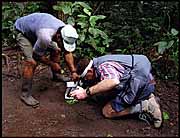 Ever wonder about the glamorous life of a wildlife photographer? Here
I am bent over a red tree frog using one hand to focus and release the
EOS-5 and 50/2.8 macro lens (in AF mode). I'm using the other hand to
hold a flash off-camera. Ramon is holding a white sheet of paper that
serves as a reflector.
Ever wonder about the glamorous life of a wildlife photographer? Here
I am bent over a red tree frog using one hand to focus and release the
EOS-5 and 50/2.8 macro lens (in AF mode). I'm using the other hand to
hold a flash off-camera. Ramon is holding a white sheet of paper that
serves as a reflector.
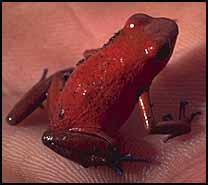
A couple of points on the trail offered nice views of the surrounding jungle
and beaches, but certainly nothing we hadn't seen from the airplane. At the
very top, we could see almost to the border with Nicaragua.
"My family lives up there," Ramon pointed toward Barra del Colorado, 20 miles
north on the coast. "My wife and six children."
How often does he see them?
"Five days a month. I take a boat up the canal, which takes about an hour and
a half, or walk up the beach, which takes five hours."
How old are the kids?
"The oldest is 15 and the youngest is six months."
We were beginning to understand Costa Rica's 2.7% growth rate [the U.S. has a
0.7% annual growth rate].

 Continue on to Corcovado
Continue on to Corcovado
philg@mit.edu
Related Links
Add a comment | Add a link
 We piled into a surprisingly large twin Piper with the pilot, a casually
dressed taciturn man with a fancy aviator's watch but no earplugs or headset.
I was relieved when he gave the engines a full run-up and also when I saw the
modern Trimble GPS unit in the dashboard, although with a blue sky and the
strong light of dawn, it would clearly be unnecessary. San Jose is at 3,773
feet [1,150 m] and we climbed to 7400 feet to get through a pass in the
mountains. The city looked beautiful. The volcanoes that had sounded so
impressive in Edgar's description just looked like mountains covered with lush
green foliage.
We piled into a surprisingly large twin Piper with the pilot, a casually
dressed taciturn man with a fancy aviator's watch but no earplugs or headset.
I was relieved when he gave the engines a full run-up and also when I saw the
modern Trimble GPS unit in the dashboard, although with a blue sky and the
strong light of dawn, it would clearly be unnecessary. San Jose is at 3,773
feet [1,150 m] and we climbed to 7400 feet to get through a pass in the
mountains. The city looked beautiful. The volcanoes that had sounded so
impressive in Edgar's description just looked like mountains covered with lush
green foliage.

 Sloth going down, Iguana going up.
Sloth going down, Iguana going up.














 Lunch was a delicious six-course communal affair. Tortuga Lodge serves the
best food that we found in Costa Rica, which was remarkable considering that
everything has to come in by truck and then up the canal for three hours. In
two days we feasted on octopus, salads with perfect tomatoes, ripe fruit,
strange vegetables, steaks, Mahi-Mahi, and chicken.
Lunch was a delicious six-course communal affair. Tortuga Lodge serves the
best food that we found in Costa Rica, which was remarkable considering that
everything has to come in by truck and then up the canal for three hours. In
two days we feasted on octopus, salads with perfect tomatoes, ripe fruit,
strange vegetables, steaks, Mahi-Mahi, and chicken.









 Ever wonder about the glamorous life of a wildlife photographer? Here
I am bent over a red tree frog using one hand to focus and release the
EOS-5 and 50/2.8 macro lens (in AF mode). I'm using the other hand to
hold a flash off-camera. Ramon is holding a white sheet of paper that
serves as a reflector.
Ever wonder about the glamorous life of a wildlife photographer? Here
I am bent over a red tree frog using one hand to focus and release the
EOS-5 and 50/2.8 macro lens (in AF mode). I'm using the other hand to
hold a flash off-camera. Ramon is holding a white sheet of paper that
serves as a reflector.

